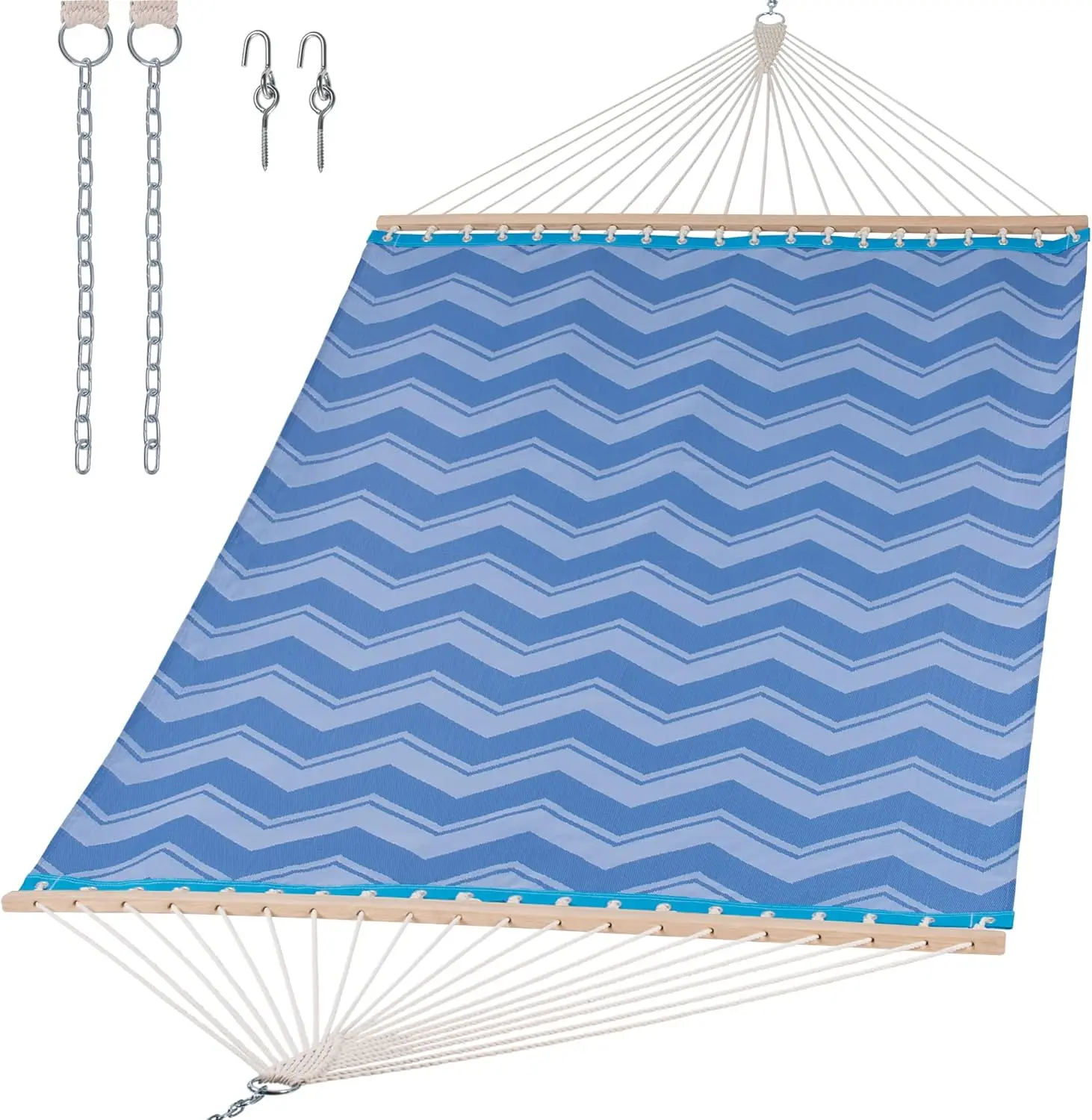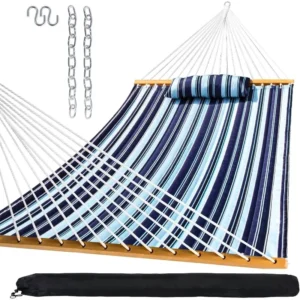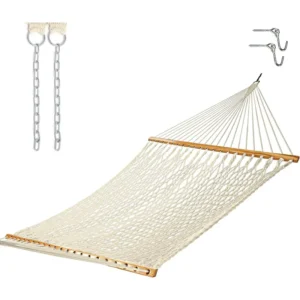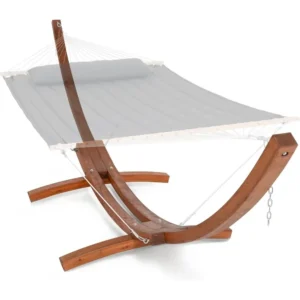Introduction: Understanding the Appeal of Framed Hammocks with Spreader Bars
Framed hammocks with spreader bars represent the perfect blend of classic relaxation and modern convenience. Unlike traditional hammocks that require trees or posts for hanging, these self-supporting designs feature their own sturdy frames, eliminating the need to search for perfect hanging spots. What truly sets them apart are the spreader bars – horizontal rods at each end that keep the hammock fabric open and flat, rather than wrapping around you like a cocoon.
This distinctive design offers immediate advantages: a flat, comfortable lying surface that’s easy to get in and out of, stability that prevents excessive swinging, and the freedom to place your relaxation spot anywhere with adequate space. As outdoor living spaces continue to evolve into extensions of our homes, these versatile hammocks have gained tremendous popularity for their furniture-like appeal and practical benefits.
Throughout this guide, we’ll explore the essential features that make framed hammocks with spreader bars worth considering – from frame construction and materials to spreader bar technology, fabric options, and more. Whether you’re looking to create a perfect hammock placement in your home or garden, or seeking the ultimate guide to framed spreader bar hammocks, this comprehensive overview will help you understand what to look for in your perfect outdoor retreat.
The Core Benefits of Self-Supporting Hammock Design
The freedom to place your hammock anywhere represents perhaps the greatest advantage of framed hammocks with spreader bars. This versatility transforms how and where you can enjoy relaxation time.
Place-Anywhere Convenience
With a self-supporting frame, you’re no longer limited by the availability of trees, posts, or sturdy anchor points. This design allows for:
- Flexible positioning – Move from sun to shade throughout the day
- Optimal location selection – Choose spots with the best views or privacy
- Use on any surface – From wooden decks to grassy lawns to poolside areas
Most standard frames require a footprint of approximately 12-15 feet (3.7-4.6 m) in length and 4-5 feet (1.2-1.5 m) in width, making them substantial but manageable in most outdoor spaces.
Enhanced Stability and Safety
Unlike traditional hanging hammocks that can swing unpredictably, framed designs offer consistent stability. The solid foundation means less swaying motion, which many users prefer for reading, conversing, or simply relaxing without constantly adjusting their position. This stability also provides peace of mind regarding hammock installation requirements and safety.
Simplified Setup and Relocation
Setting up a framed hammock typically involves a one-time assembly process, after which you can simply move the entire unit as needed. This eliminates the recurring installation challenges associated with finding proper hanging points, testing anchor strength, and ensuring proper hanging angles.
For those who appreciate both versatility and convenience, our collection of spreader bar hammock sets offers complete solutions that arrive with everything needed for immediate enjoyment.
Frame Materials and Construction: The Foundation of Quality
The frame forms the literal foundation of your hammock experience, determining its stability, durability, and overall aesthetic. Understanding the strengths and limitations of different materials helps ensure you select the best option for your needs.
Comparing Common Frame Materials
Powder-Coated Steel
Steel frames offer exceptional strength and stability, typically supporting the highest weight capacities (often 350-450 pounds or 159-205 kg). The powder coating creates a weather-resistant barrier that protects against rust and corrosion, though quality varies significantly between manufacturers. Premium steel frames often feature thicker tubing, reinforced joints, and superior coating processes.
Wood Options
Wooden frames provide a natural, organic aesthetic that many find visually appealing. Common woods include:
* Cypress – Naturally resistant to decay and insects
* Larch – Excellent durability with attractive grain patterns
* Pine – More affordable but requires more maintenance to preserve
Wooden frames typically develop a beautiful patina over time but require more regular maintenance than metal alternatives.
Aluminum
Aluminum frames offer a lightweight yet strong alternative, making them easier to move around your property. Their natural corrosion resistance makes them ideal for coastal environments or areas with high humidity. While they generally support slightly lower weight capacities than steel, premium aluminum frames still provide excellent stability.
Frame Design Elements
The construction design significantly impacts stability and user experience:
* Arc-shaped frames distribute weight more evenly and create a gentle rocking motion
* Straight-beam designs offer maximized stability with minimal movement
* Base width directly correlates to tip-resistance – wider bases prevent unwanted tipping
For those seeking maximum durability and strength, exploring top features of heavy-duty hammock frames provides valuable insights into what separates premium options from basic models.
Our selection of heavy-duty hammock sets includes options specifically engineered for exceptional stability and longevity, with reinforced construction and premium materials.
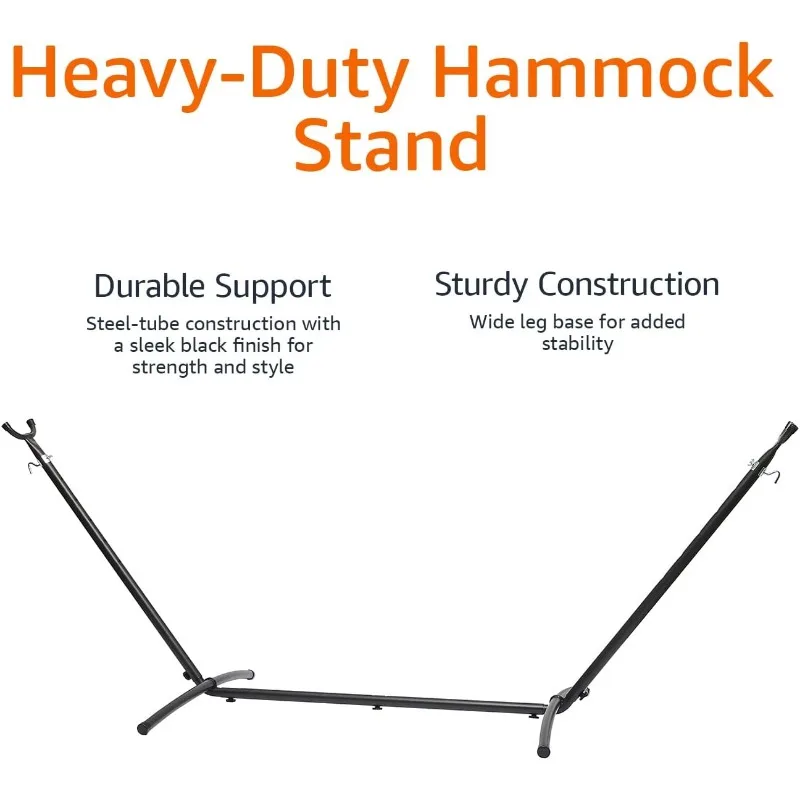
Spreader Bar Technology: Creating the Perfect Lounging Surface
Spreader bars represent the defining feature that gives these hammocks their distinctive flat, open sleeping surface. These horizontal rods attach at each end of the hammock, stretching the fabric or rope to create a taut surface that remains flat when in use.
Function and Design Impact
Spreader bars serve several critical functions:
* Maintaining an open hammock bed that doesn’t wrap around the user
* Creating a more furniture-like appearance compared to traditional gathered-end hammocks
* Allowing for easier entry and exit
* Providing enhanced airflow around the body on hot days
The standard width for spreader bars typically ranges from 30-42 inches (76-107 cm), with wider bars generally providing more stability and preventing the “tipping” sensation that can occur with narrower designs.
Material Considerations
Hardwoods
Traditional hardwood spreader bars (typically oak, cypress, or similar hardwoods) offer classic aesthetics and substantial weight. Their beauty and natural feel make them popular choices, though they require occasional maintenance to prevent weathering and splitting.
Composite Materials
Modern composite spreader bars combine wood fibers with resin to create highly durable, weather-resistant alternatives to solid wood. These materials resist splitting, warping, and fading while maintaining a wood-like appearance.
Metal Options
Some contemporary designs utilize aluminum or powder-coated steel bars that offer maximum durability and minimal maintenance. While less traditional in appearance, these materials provide excellent longevity and consistent performance.
The design of hammocks with spreader bars and standing frames has evolved significantly, with manufacturers finding increasingly effective ways to optimize the balance between comfort, stability, and ease of use.
Hammock Bed Materials: Finding Your Comfort Zone
The material that actually supports your body plays perhaps the most significant role in your overall comfort experience. Different materials offer varying levels of softness, breathability, durability, and weather resistance.
Fabric Options
Cotton
Cotton hammock beds offer exceptional softness and breathability, creating a naturally comfortable surface against the skin. However, traditional cotton requires more maintenance and has shorter outdoor lifespan:
* Natural feel and excellent breathability
* Absorbs moisture rather than repelling it
* Requires bringing indoors during wet weather
* May develop mildew if left damp
* Generally 2-5 year lifespan with regular outdoor use
Polyester
Modern polyester hammock beds provide an excellent balance of comfort and durability:
* Quick-drying properties (typically 2-4 hours in sunny conditions)
* Good UV resistance with minimal fading
* Soft feel with proper weaving techniques
* Resistant to mildew and mold
* Generally 5-8 year lifespan with regular outdoor use
DuraCord and Solution-Dyed Acrylics
These premium synthetic options offer the best longevity and weather resistance:
* Superior UV stability with minimal fading for 5+ years
* Excellent moisture resistance with quick-drying properties
* Maintains softness even after years of exposure
* Resistant to staining, mildew, and environmental damage
* Generally 8-10+ year lifespan with proper care
Rope vs. Fabric Construction
Hammock beds generally come in two distinct construction types:
Rope Hammocks feature an open weave pattern that maximizes airflow and creates the classic hammock look. They excel in hot climates where breathability is paramount but may leave imprint patterns on skin during extended use.
Fabric Hammocks provide a solid sleeping surface that offers more support and prevents small items from falling through. These designs excel for reading, as books and devices remain secure on the surface.
For those seeking the classic experience, our rope hammock sets offer traditional comfort with modern durability enhancements, while our fabric hammock sets provide a contemporary solution with maximum comfort.
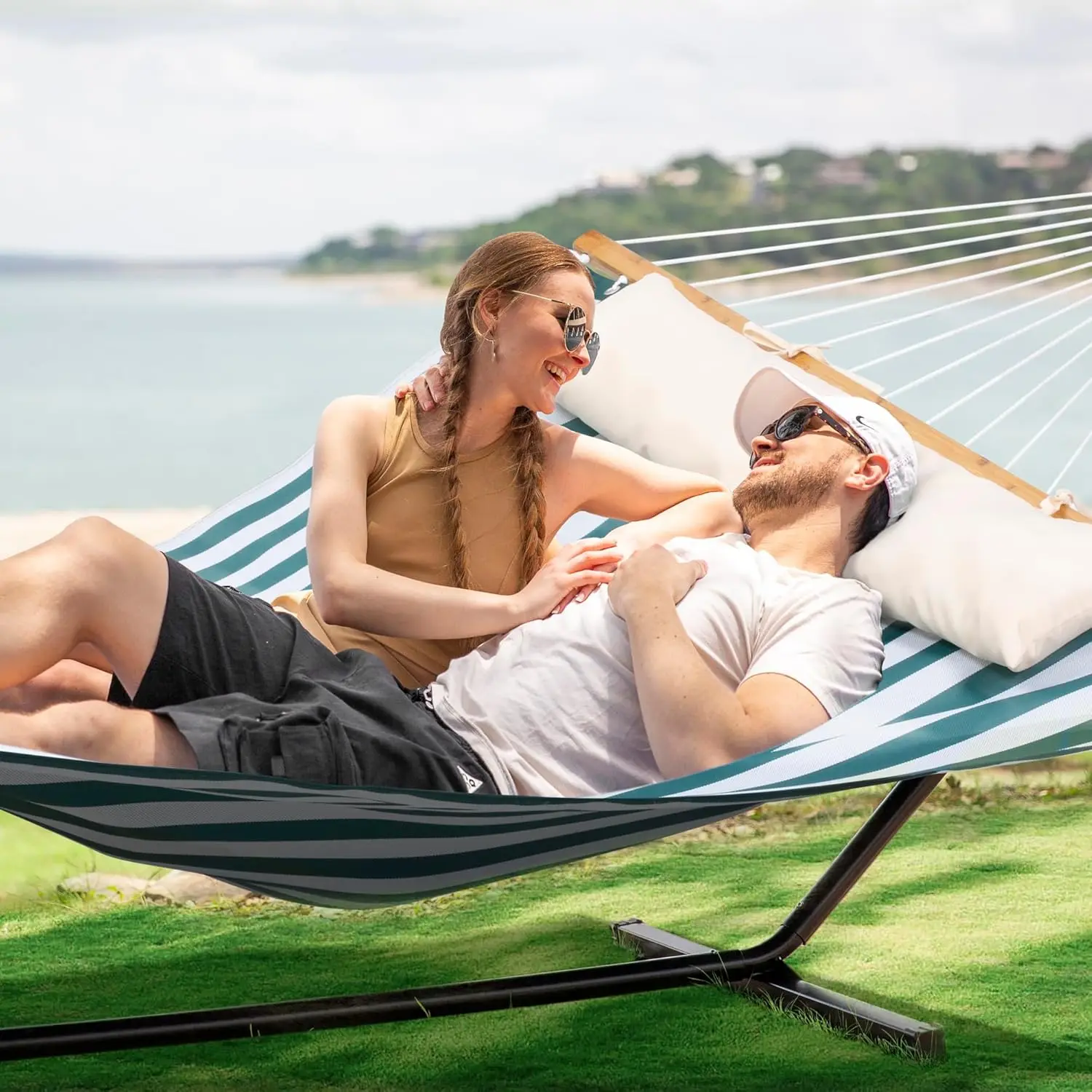
Suspension Systems: Connecting Comfort to Structure
The suspension system forms a critical link between the hammock bed and frame, directly impacting comfort, adjustability, and safety. Though often overlooked, these components deserve careful consideration.
Hardware Quality Indicators
The chains, hooks, and connectors that make up the suspension system should feature:
* Corrosion-resistant materials – Stainless steel or heavily galvanized components resist rust and degradation
* Smooth, finished edges – No sharp points that could damage fabric or cause injury
* Appropriate thickness – Chain links and hardware properly sized for the weight capacity
* Secure closures – S-hooks with tight gaps or safety closures to prevent accidental disconnection
Quality hardware typically features zinc-plated steel for moderate environments or marine-grade stainless steel for coastal locations. The difference in longevity makes premium hardware worth the investment.
Adjustment Capabilities
A proper suspension system allows for tension adjustment to customize your lounging experience:
* Multiple hanging points accommodate different body weights and preferences
* Chain systems allow for easy height adjustments
* Quick-adjust mechanisms enable changing from flat to reclined positions
Understanding proper tension is essential for both comfort and safety, as covered in our indoor and outdoor hammock safety guide that addresses common concerns about proper setup.
Size and Dimension Guide: Finding Your Perfect Fit
Selecting the right size hammock ensures optimal comfort for intended users while making efficient use of available space. Consider both the hammock bed dimensions and the overall footprint required.
Standard Hammock Sizes
| Size Category | Hammock Width | Ideal For | Typical Weight Capacity |
|---|---|---|---|
| Single/Personal | 4-5 ft (1.2-1.5 m) | Individual relaxation | 275-350 lbs (125-160 kg) |
| Double/Large | 5-6 ft (1.5-1.8 m) | Couples or extra space | 350-450 lbs (160-205 kg) |
| Extra Large | 6-7 ft (1.8-2.1 m) | Family use or maximum space | 450-600 lbs (205-270 kg) |
Space Requirements
For comfortable use, plan your space considering these guidelines:
* Total frame length: 12-15 feet (3.7-4.6 m)
* Total frame width: 4-5 feet (1.2-1.5 m)
* Clearance around frame: 2-3 feet (0.6-0.9 m) on all sides for easy access
When considering placement inside your home, our guide on the best places to hang a hammock indoors provides valuable insights on finding suitable locations that work with these dimensions.
For those seeking to accommodate two people comfortably, our selection of double two-person hammock sets offers spacious options specifically designed for shared relaxation.
A-Frame Stand Hammock Sets, Swinging Hammock Chair Sets
$154.62 Select options This product has multiple variants. The options may be chosen on the product pageClassic Wooden Stand Hammock Sets, Heavy Duty Hammock Sets
$1,061.68 Select options This product has multiple variants. The options may be chosen on the product pageHammock Sets with Canopy, Heavy Duty Hammock Sets
$286.31 Select options This product has multiple variants. The options may be chosen on the product pageDouble / Two Person Hammock Sets, Rope Hammock Sets
Double Traditional Cotton Rope Hammock with Extension Chains – 450 lbs Capacity for Backyard & Patio$292.98 Select options This product has multiple variants. The options may be chosen on the product pageHeavy Duty Hammock Sets, Wooden Arc Stand Hammock Sets
$878.66 Select options This product has multiple variants. The options may be chosen on the product page
Weight Capacity: Understanding Safety Limits
Weight capacity represents one of the most critical safety specifications for any hammock system. Manufacturers determine these limits through structural testing, applying safety factors to ensure performance under real-world conditions.
Most quality framed hammocks with spreader bars offer capacities between 275-450 pounds (125-205 kg), with premium models supporting up to 600 pounds (272 kg) or more. These ratings account for:
* The combined strength of the frame materials
* The load-bearing capacity of all connection points
* The tensile strength of the hammock bed material
* Structural stability under dynamic (moving) loads
Exceeding the stated weight capacity compromises safety and accelerates wear on all components. Signs of stress may include:
* Creaking or unusual noises from the frame
* Visible bending or flexing of structural components
* Stretching or distortion of the hammock bed material
* Chain or hardware deformation
For maximum stability and peace of mind, especially for larger individuals or couples, our A-frame stand hammock sets feature reinforced designs specifically engineered to provide superior support and stability.
Weather Resistance Features: Protecting Your Investment
Exposure to sun, rain, humidity, and temperature fluctuations can significantly impact the lifespan of outdoor furniture. Quality hammocks incorporate specific features to combat these environmental challenges.
UV Protection Technologies
Continuous sun exposure represents perhaps the greatest threat to hammock longevity. Quality materials incorporate:
* UV stabilizers that prevent molecular breakdown from solar radiation
* Colorfast dyes that resist fading even after years of exposure
* Protective coatings that reflect harmful rays
Premium synthetic fabrics typically maintain 90%+ of their tensile strength after 1,000+ hours of UV exposure testing, while untreated materials may deteriorate significantly within a single season.
Water Resistance Considerations
How your hammock handles moisture directly impacts its durability:
* Quick-drying materials prevent mildew growth
* Water-repellent treatments cause moisture to bead and roll off
* Proper drainage design prevents water pooling in fabric
* Rust-resistant hardware maintains structural integrity
For those wondering “is it okay to leave a hammock outside?”, the answer depends largely on these specific weather-resistant features and your local climate conditions.
Essential Maintenance Tips for Longevity
With proper care, a quality framed hammock with spreader bars can provide many seasons of enjoyment. Following these maintenance practices significantly extends the lifespan of all components:
Frame Care
- Clean metal frames with mild soap and water seasonally
- Treat wooden frames with appropriate sealant annually
- Inspect for and tighten loose hardware monthly
- Store frame components in covered location during extended non-use
Fabric/Rope Maintenance
- Rinse fabric with clear water to remove pollen and debris
- Clean spills promptly with appropriate cleaners
- Allow to dry completely before storage
- Avoid harsh chemical cleaners that break down fibers
Hardware Attention
- Check chains and hooks for signs of wear or corrosion
- Apply silicone lubricant to moving parts annually
- Replace any components showing significant rust or damage
For seasonal storage, disassemble if practical and store components in a dry location. Alternatively, use a weather-resistant cover designed specifically for hammocks when not in use for extended periods.
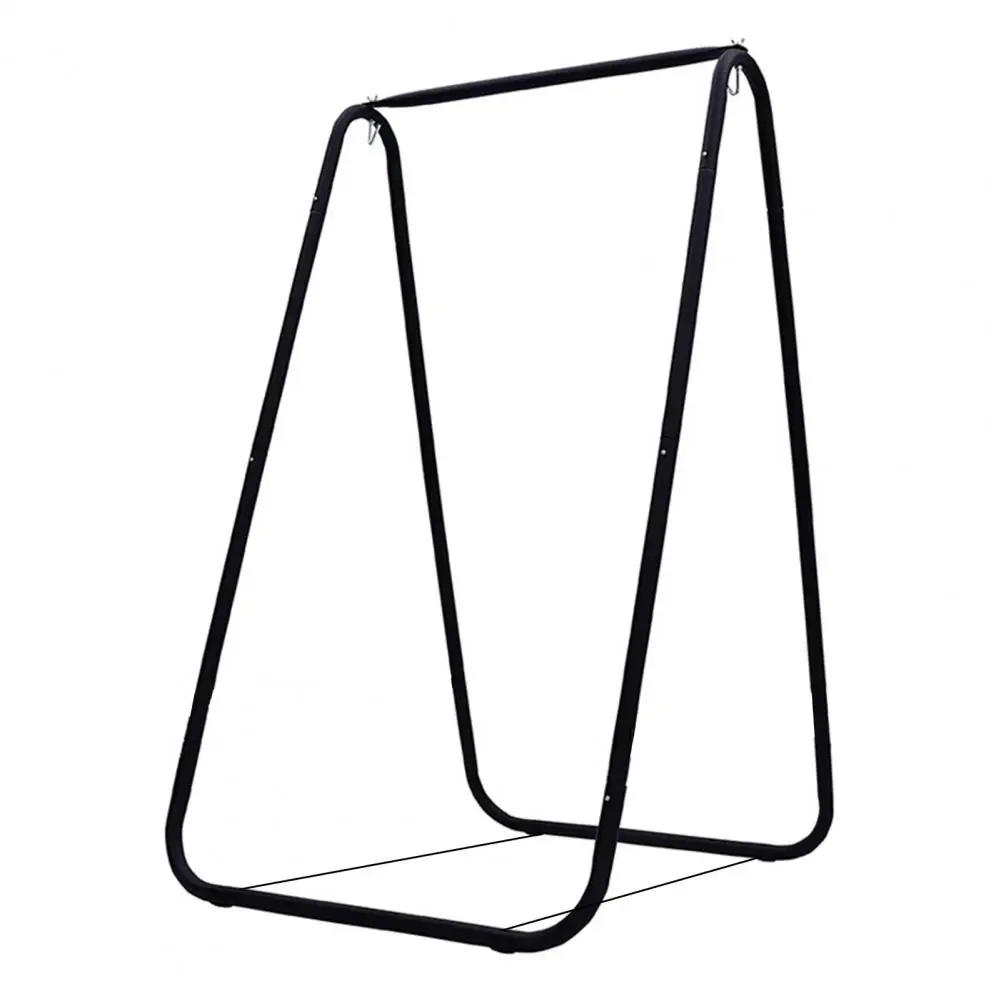
Buying Considerations: Finding Your Perfect Match
Selecting the ideal framed hammock with spreader bars involves matching product features with your specific needs, environment, and preferences.
Personal Assessment Checklist
Begin by evaluating your unique requirements:
* Available space – Measure carefully before selecting frame size
* Primary activities – Reading requires different features than napping
* User count – Solo relaxation or shared experience with partner
* Weather exposure – Full sun requires different materials than covered areas
* Aesthetic preferences – Traditional appearance or contemporary design
* Mobility needs – How often will you need to move the hammock?
Budget Considerations
Quality hammock systems typically fall into three general price categories:
* Entry-level ($150-300) – Basic functionality with moderate durability
* Mid-range ($300-600) – Better materials, enhanced comfort, and longer lifespan
* Premium ($600+) – Superior construction, maximum comfort, and extended durability
The most cost-effective approach typically involves purchasing a complete system rather than individual components, ensuring compatibility and cohesive design.
Finding the perfect hammock placement for your home or garden helps maximize enjoyment of your investment while ensuring proper fit within your outdoor living space.
Design and Aesthetic Options: Style Meets Function
Today’s framed hammocks with spreader bars offer diverse style options that complement virtually any outdoor décor theme. Aesthetic considerations include:
Color and Material Palettes
- Natural wood tones – Cypress, oak, and larch provide warm, organic appeal
- Contemporary metals – Matte black, brushed aluminum, or bronze powder coatings
- Fabric colors – From neutral tans and whites to vibrant patterns and stripes
- Rope variations – Traditional white, natural hemp tones, or colorful synthetic options
Design Approaches
- Modern minimalist – Clean lines, monochromatic color schemes, and simple hardware
- Traditional/classic – Wooden frames, rope construction, and timeless patterns
- Tropical resort – Bright colors, wooden accents, and vacation-inspired details
- Contemporary outdoor – Mixed materials, architectural influences, and fashion-forward colors
The visual impact of your hammock can either make it a subtle background element or a striking focal point within your outdoor space. Our diverse collection of hammocks with stands offers options to complement any design aesthetic while maintaining the functional benefits that make these relaxation systems so popular.
Beyond Basic Hammocks: Enhanced Relaxation Options
While a framed hammock with spreader bars provides an exceptional relaxation experience on its own, several enhancements can elevate your comfort even further:
Sun Protection Solutions
Attachable canopies and sunshades provide protection from UV rays and excessive heat, extending comfortable use hours during summer months. These attachments typically mount directly to the frame, allowing for adjustment as the sun moves.
Comfort Accessories
Dedicated hammock pillows contoured to provide neck and head support significantly enhance reading comfort. Quilted padding layers can transform the hammock experience, providing additional cushioning for extended lounging.
Convenience Add-ons
Side tables and cup holders attach to the frame, keeping beverages, books, and personal items within easy reach. These practical additions eliminate the need to disturb your relaxation to retrieve essentials.
Protective Equipment
Weather-resistant covers extend the lifespan of your investment by providing protection during inclement weather or off-season periods. These covers typically feature breathable yet water-resistant materials that prevent moisture accumulation.
Are Framed Hammocks with Spreader Bars Right for Everyone?
While framed hammocks with spreader bars offer numerous advantages, they may not represent the perfect solution for every situation or user. Consider these factors when determining if this style meets your specific needs:
Space Considerations
The substantial footprint required (typically 12-15 feet in length) may not work for compact patios, balconies, or limited yard spaces. Traditional hanging hammocks can accommodate smaller areas when anchor points are available.
Portability Limitations
The weight and assembly requirements make these hammocks less practical for camping, travel, or frequent relocation compared to lightweight travel hammocks that pack into small stuff sacks.
Budget Impact
Quality framed systems require greater initial investment than simple hanging hammocks. For occasional or seasonal use, simpler options might provide better value.
Lounging Preferences
Some users prefer the cocooning effect of traditional hammocks, which wrap slightly around the body, rather than the flatter surface provided by spreader bar designs.
For those whose needs align with their benefits, framed hammocks with spreader bars provide an exceptional blend of convenience, comfort, and stability that enhances outdoor living spaces for years to come.
What Makes a Quality Hammock Stand Out? Expert Assessment Criteria
When evaluating hammock quality, experts focus on specific indicators that predict long-term satisfaction and durability:
Construction Excellence
Quality systems feature precision-cut components that align perfectly, with no gaps at joints or connection points. Welds should be continuous and smooth on metal frames, while wooden components should show tight joinery and proper finishing.
Material Consistency
Premium hammocks use consistent materials throughout – no mixing of different grades or thicknesses to reduce costs in less visible areas. This uniformity ensures balanced strength throughout the system.
Hardware Details
Quality is often revealed in the smallest components – look for stainless steel or properly galvanized hardware, smooth edges on all metal parts, and thoughtfully designed connection systems that eliminate pressure points.
Warranty Confidence
Manufacturers who stand behind their products typically offer comprehensive warranties covering all components. The length and terms of the warranty often reflect the manufacturer’s confidence in their materials and construction.

